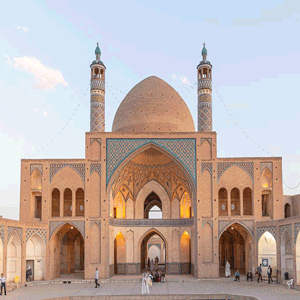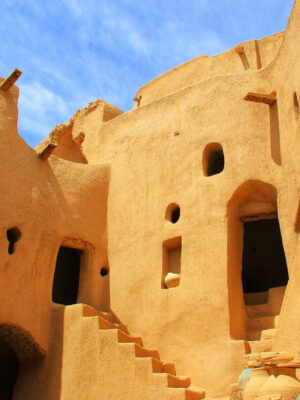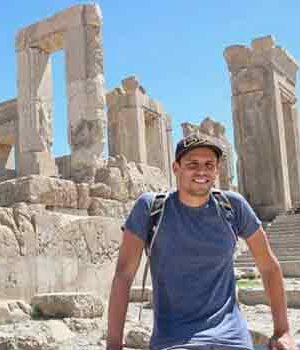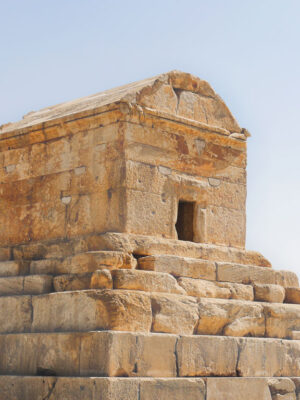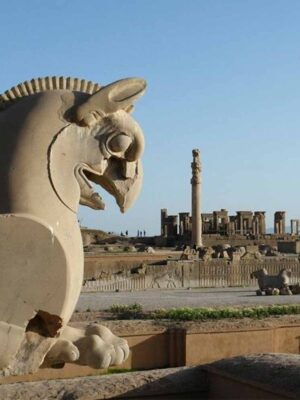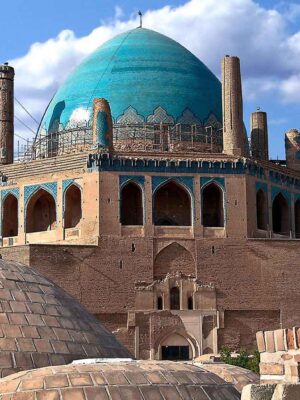Muharram and Ashura
Ashura is a Shi’ite mourning festival related to the Shi’ite sect of Islam which is one the two main branches of Islam. Shiism is the sect of Islam which was selected, admired and followed throughout the history by the great majority of Iranian Muslims. But Ashura, of course, is not exclusive to Iran and it is celebrated, however differently amongst the Shias in different parts of the world in Islamic countries.
After the death of prophet Mohammad, the Shias insisted that the leadership of the Muslim society should pass down amongst the people who had a link by blood to the prophet Mohammad; Because this idea was supported by Ali, the people who followed this theory are called Shias or Shi’ite meaning “followers” of Ali who is the son –in –law of the prophet Mohammad and his cousin who got married with Fatimah his daughter. Ali is considered the first Imam for the Shias and the father of Hassan and Hussein the second and third imams for the Shias. “Shi’ite” itself Is an Arabic word literally meaning” a follower “which refers to a Muslim or a group of Muslims who follow Imam Ali, the first Imam of Shi’ite.
In Ashura, the tragedy is the sad result of the confrontation between Imam Hussein who was representative of Justice and innocence, along with his small group of family members and followers versus his enemies. The Battle of Ashura was in fact a fight between Good versus Evil or justice versus injustice. Opposite Imam Hussein there was a large group of Umayyads who were representative of injustice, tyranny, and oppression. A tragic atmosphere which eventually ended up with Imam Hussein, his followers and loved ones’ martyrdom. The Men of Yazid, the second Umayyads’ troops had no mercy even to Imam Hossein’s beloved white horse” Zoljanah” (meaning the owner of 2 wings) by shooting numerous arrows at it.
Imam Hussain, as the symbol of Loyalty and truth, versus Yazid, son of Muawiah, who symbolizes injustice and oppression, creates a theme in the history of Muslims which is celebrated in the history every year under the title of “Ashura”
Thus, the event of Ashura reminds every Muslim, the oppression from which Imam Hussein and his family suffered individually or the whole Shi’ite nation.
Hussein who is the grandson of the prophet Mohammad, is killed in the Battle of Ashura. However, his death is not considered as a normal death, but “Martyrdom” which is giving life for the sake of religion and rescuing the religion of Islam.
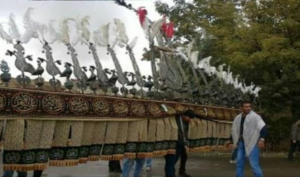
Hussein is known as a martyr and he is standing in the first line of martyrs in Shia sect of Islam. By giving his life in the battle of Ashura in 680 AD, Imam Hussein rescued and saved Islam which was about to disappear by the wrong deeds of Umayyad Caliph of the time, Yazid. Imam Hussein’s life was contemporary to Yazid from the Umayyad family who ruled in Damascus. Ashura is not of course exclusive to Iran and it’s Shi’ite society, but is practiced throughout the Islamic world of Shi’ite Islam. However, there are some Ashura practices which are particular to Iran or at least originated in ancient Iran.
Ashura, the tenth of the Month of Muharram, is the annual day of Imam Hussein’s martyrdom and from that day onwards the Shias, physically and emotionally, understood the real meaning of martyrdom.
FESTIVAL
Although the Ashura mourning festival (the ritual of Ashura) is practiced throughout the Shi’ite world of Islam, but there are some specific rituals which are associated only with Shias in Iran. However, the very basic mourning festival is pretty the same all over. Ashura festival is held to remember the sad theme and sorrowful story of the catastrophic ending of Imam Hussein, which happened to such an important person as the grandson of the prophet Mohammad, and the members of his small camp (family members, followers, his kids and infants). on the other side was the great army of Yazid, Umayyad Caliph out from Damascus, who ordered the massacre.
The mourning festival in reality takes 10 days, because the same number if days the siege of the Hussein’s camp in the desert of Karbala lasted was 10 days.
Every year, the first sign showing that the decade of Ashura and the time for mourning festival is nearing is that the color of the people’s clothes in public changes all to the darkest black. Gradually in the 3rd and 4th days of the month of Muharram, the general atmosphere of the mosques, Shi’ite mausoleums, holly shrines, changes and many people by fixing black flag at the threshold of their houses get ready to observe the festival of Ashura.
Some however, fix red flags instead representing red color of imam Hussein’s blood. One of the main Ashura rituals is the ritual of self-flagellation which normally is performed in a procession form. In these processions which are done all by males, having a wooden handled chain called Zanjeer, which they use to whip their backs over the shoulders. In these mourning festival females slowly follow the processions along with the very young kids and form a parade in the street. one person ahead of all the others chants sad songs in loud speakers and the others repeat the songs and cry.
The entire 10 days ceremony continues until the midday of the 10th day. This is when the ceremony of Ashura reaches its climax and mourners act with more excitement; because in the reality and in the actual time, Imam Hussein got martyred in the midday of the 10th of Muharram 680 AD in the battlefield of Karbala.
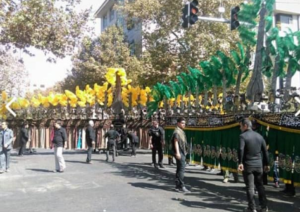
Ahead of any Ashura procession there is always an extremely heavy engraved brass standard called “Alam or Alamat”, beautifully decorated by colorful fabrics and natural large birds feathers carried by strongest man of the group. The brass Standard signifies a similar model of what imam Hussain was carrying as a banner in front of his small army in the battlefield of Ashura.
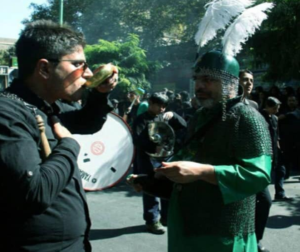

Muharram
Muharram is the name of the first month of the lunar Arabic year. But for the Shi’ite society, Muharram represents the month on the 10th day of which their favorable Imam Hussein and his family and followers were martyred. Every year at the same time Iranians celebrate Muharram in public processions, or in the way that they think it’s appropriate in their own mind. Muharram is the month of the year that people distribute charity food called” Nazri” or if they can’t afford it, they simply offer to the mourners hot milk or soup. By giving charity of any sort, every individual Shi’ite makes his contribution to the others. The main aim for the rituals of Muharram is for people to display their dissatisfaction of Imam Hussein’s martyrdom by Yazid in a disastrous way, and to remember to what Imam Hussein did, what he said and what his aim was. This feeling changes the entire atmosphere of Iranian cities somehow, and even the believers of other religions such as the Jews, Zoroastrians and Christians also sympathize and follow the general atmosphere in the month of Muharra. People may take part in the self-flagellations, or they may watch the passion plays called” Tazieh” in which the performers play the role of positive and negative characters of the event of Ashura. Every Tazieh performer tries to act the characters in the battlefield and express all what happens in battle of Ashura in Muharram 680 AD.
Ashura definition
Ashura literally means the tenth day and refers to the tenth day of the month of Muharram. The word which itself derives from “ASHAR” in Arabic; Basically, because the event of the main confrontation of the small troop of Hussain with the large army of Yazid in the battlefield of Karbala, occurred in 680 A.D when Imam Hussein and his people were wrongfully massacred.
Ashura fasting
Fasting was made noncompulsory for the Shi’ite in Iran during the month of Muharram and Ashura festival by the Shia Scholars. However, in Sunni Islam they choose to fast during 9th day called “Tasua” and the10th day called “Ashura” of the month of Muharram. Sunni Muslims also mourn in Ashura and keep the memory of Imam Hussein, the grandson of prophet Mohammad alive. According to one of the prophet Mohammad’s Hadiths (Mohammad the prophet’s narrations Mohammad) he is quoted fasting during these two days meanwhile he stayed in Mecca. It is believed that Sunnis fast during these two days to commemorate the traditions of the prophet Mohammad.
Ashura celebration
Ashura is celebrated in many Muslim countries. For one of the two main sects of Islam (Shiism), Ashura is considered as a very main mourning festival. Both Shias and Sunnis celebrate Ashura however differently in their own way. It seems that both sects highly respect this day. Shias are more focused on Imam Hussein’s oppression, his innocence and his philosophy of putting himself in such a horrible situation in the battlefield in Karbala desert. This sad story of course ended up with Imam Hussein and his followers being massacred by Yazid’s troops and this is known as a true example of martyrdom.
In the Ashura mourning celebrations today, the Shi’ites try their best to keep alive Imam Hussein’s philosophy and motivations by making lines of mourners in the street, chanting sad songs about the event of Ashura and participate in the Ashura parade.
Amongst the Sunnis and followers of Sunnah sect of Islam, the meaning of Ashura is celebrating and mourning simply in the honor of the grandson of the prophet Mohammad and the sad way that he was killed. Many Sunnis believers are said to fast during these 2 days of Tasua (the day before Ashura) and Ashura.
History of Ashura
Based on the History of early years of Islam; After the death of the prophet Mohammad in 632 A.D, a discussion emerged between the Shias (literally means followers of Ali) and the Sunnis who were the majority of the Muslims about the times of Mohammad’s succession. The Shi’ite believed that succession had to remain in the close family of the prophet Mohammad, Whereas the Sunni believed in Caliphate which meant “(deputy of God)”. Thus, a Caliph is considered the deputy of God who has the right to rule over the people in Muslim society. Immediately after the death of prophet Mohammad and meanwhile the Shias expectation was for Ali to become the successor of Mohammad, the Sunnis who were and have always been the majority, gathered in the mosque of Madinah and selected Abu Bakr.
Abu Bakr was also a brave man and had been a companion of the prophet Mohammad in all the religious wars (Ghazvahs). The system of election was continued by the election of Omar and Othman. Ali, the son-in-law and cousin of the Mohammad, eventually succeeded to become the leader of Muslim society after 25 years of Mohammad’s passing away. Thus, Ali is Caliph number 4 for Sunnis and off course number 1 imam for the Shias. Imam Ali himself who was Mohammad’s successor was assassinated in 661 A.D in the mosque of Kufa in the modern-day Iraq.
Imam Ali, in his capital Kufa, was facing Muawiah, another strong character from the famous Umayyad family not acknowledging Ali as” Amir Al Momenin “or the Caliph of all Muslims. Muawiah announced autonomy and disobedience from Ali and selected Damascus as his capital. There were now two Caliphs, Muawiah from Umayyid family in Damascus and Ali in Kufa at the same time.
Ali is considered at this time the first Imam for the Shi’ites and the 4th Caliph for the Sunnis.
Yazid succeeded his father Muawiah and became the next Umayyad Caliph in Damascus in 680 A.D.
Imam Hussein, the second son of Imam, Ali the first imam of Shia, becomes the third imam for the Shias.
Imam Hussein in this time refuses to acknowledge the legitimacy of Yazid’s leadership of Muslim society.
Yazid son of Muawiah, the caliph from Damascus orders imam Hussein to obey him and acknowledge the legitimacy of his caliphate. Yazid ordered Imam Hussein to call him the caliph of all Muslim and respect him. Yazid son of Muaviah from the Umayyad family did not deserve the title of a Caliph.
Imam Hussein refused to accept Yazid’s right for Caliphate and called him an illegitimate caliph. Thus, Imam Hussain had to leave Medina, a city in modern Arabic peninsula and head to Kufa in modern day Iraq. Imam Hussein had discovered that he and his people would be so welcomed in Kufa, based on so many encouraging invitations that he had received from the people of Kufa. In Imam Hussein’s camp there were his wives, children, sisters, brothers, and some close friends and followers. Imam Hussain’s camp was seized in Karabala (a desert outside Kufa). The Umayyad (Yazid’s army) cut off water and food to Imam Hussain and his companion’s camp. A siege that took 10 days long followed. In the midday of the 10th day, the large army of Yazid attacked the small camp of imam Hussein and brutally massacred them all. Imam Hussain himself was beheaded and his head was carried to Damascus to be shown as a proof of his death to Yazid. Imam Hussain’s brave sister Zeynab, His sick brother Mohammad and some of the followers were all arrested and sent to Damascus as prisons of war.
Facts of Ashura
There are so many facts about Ashura has survived so many centuries later, the fact is that the sympathy of Muslims towards the event is still alive. Ashura happened in the 10th of October 680 AD, equivalent to 10th of month of Muharram in the year 61 Hejira. The base of Arabic lunar Calendar is the migration of Mohammad the prophet from Mecca to Medina (2 cities in the Arabic peninsula). The main fact about Ashura is that the Shi’ite Muslims, every year and at the same time, do an amazing mourning festival called Ashura and remember Imam Hussain and his attendant’s suffering in an unequal battle in the desert of Karbala. The strong character of Zeynab, Imam Hussain’s sister, a very tough lady, who was taken as a prisoner of war to Damascus to the presence of Yazid the caliph is a remarkable fact of Ashura. Zeynab as a very strong character made a shocking speech right in front of Yazid’s eyes in his court condemning the violence and injustice to his brother and his followers. Every detail of the event of Ashura’s disaster is played as a part of the Ashura mourning in Taziah, which is a pure Shi’ite performance. Taziah is a performance based on Ashura story and is very similar to the performance in a theatre, except in Tazieh, the performers play the characters of the event of Ashura. In Taziah, one person plays the role of Zeynab, and another plays the role of Yazid and all the others. A large group of mourners watch these performances and cry.
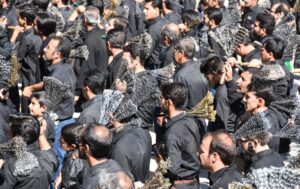
Symbolism of Karbala
Symbolism of Karbala for the Shias is mainly focused on Imam Hussein’s martyrdom, his compassion and his innocence which ended up with his beheading and martyrdom. The members of his camp were slaughtered or were arrested and moved harshly to Damascus. Symbolism of Karbala is the story of resistance of a small group of good people in front of the oppression and force of the large army of evil people. Symbolism of Karbala is the triumph of innocent blood over the swords which in the long term will be achieved. And eventually the symbolism of Karbala is that the bravery of Imam Hussein kept the religion of Islam alive by refusing to accept and acknowledge Yazid’s supervision on the Muslim society.
Muharram and Ashura
Ashura is a Shi’ite mourning festival related to the Shi’ite sect of Islam which is one the two main branches of Islam. Shiism is the sect of Islam which was selected, admired and followed throughout the history by the great majority of Iranian Muslims. But Ashura, of course, is not exclusive to Iran and it is celebrated, however differently amongst the Shias in different parts of the world in Islamic countries.
After the death of prophet Mohammad, the Shias insisted that the leadership of the Muslim society should pass down amongst the people who had a link by blood to the prophet Mohammad; Because this idea was supported by Ali, the people who followed this theory are called Shias or Shi’ite meaning “followers” of Ali who is the son –in –law of the prophet Mohammad and his cousin who got married with Fatimah his daughter. Ali is considered the first Imam for the Shias and the father of Hassan and Hussein the second and third imams for the Shias. “Shi’ite” itself Is an Arabic word literally meaning” a follower “which refers to a Muslim or a group of Muslims who follow Imam Ali, the first Imam of Shi’ite.
In Ashura, the tragedy is the sad result of the confrontation between Imam Hussein who was representative of Justice and innocence, along with his small group of family members and followers versus his enemies. The Battle of Ashura was in fact a fight between Good versus Evil or justice versus injustice. Opposite Imam Hussein there was a large group of Umayyads who were representative of injustice, tyranny, and oppression. A tragic atmosphere which eventually ended up with Imam Hussein, his followers and loved ones’ martyrdom. The Men of Yazid, the second Umayyads’ troops had no mercy even to Imam Hossein’s beloved white horse” Zoljanah” (meaning the owner of 2 wings) by shooting numerous arrows at it.
Imam Hussain, as the symbol of Loyalty and truth, versus Yazid, son of Muawiah, who symbolizes injustice and oppression, creates a theme in the history of Muslims which is celebrated in the history every year under the title of “Ashura”
Thus, the event of Ashura reminds every Muslim, the oppression from which Imam Hussein and his family suffered individually or the whole Shi’ite nation.
Hussein who is the grandson of the prophet Mohammad, is killed in the Battle of Ashura. However, his death is not considered as a normal death, but “Martyrdom” which is giving life for the sake of religion and rescuing the religion of Islam.

Hussein is known as a martyr and he is standing in the first line of martyrs in Shia sect of Islam. By giving his life in the battle of Ashura in 680 AD, Imam Hussein rescued and saved Islam which was about to disappear by the wrong deeds of Umayyad Caliph of the time, Yazid. Imam Hussein’s life was contemporary to Yazid from the Umayyad family who ruled in Damascus. Ashura is not of course exclusive to Iran and it’s Shi’ite society, but is practiced throughout the Islamic world of Shi’ite Islam. However, there are some Ashura practices which are particular to Iran or at least originated in ancient Iran.
Ashura, the tenth of the Month of Muharram, is the annual day of Imam Hussein’s martyrdom and from that day onwards the Shias, physically and emotionally, understood the real meaning of martyrdom.
FESTIVAL
Although the Ashura mourning festival (the ritual of Ashura) is practiced throughout the Shi’ite world of Islam, but there are some specific rituals which are associated only with Shias in Iran. However, the very basic mourning festival is pretty the same all over. Ashura festival is held to remember the sad theme and sorrowful story of the catastrophic ending of Imam Hussein, which happened to such an important person as the grandson of the prophet Mohammad, and the members of his small camp (family members, followers, his kids and infants). on the other side was the great army of Yazid, Umayyad Caliph out from Damascus, who ordered the massacre.
The mourning festival in reality takes 10 days, because the same number if days the siege of the Hussein’s camp in the desert of Karbala lasted was 10 days.
Every year, the first sign showing that the decade of Ashura and the time for mourning festival is nearing is that the color of the people’s clothes in public changes all to the darkest black. Gradually in the 3rd and 4th days of the month of Muharram, the general atmosphere of the mosques, Shi’ite mausoleums, holly shrines, changes and many people by fixing black flag at the threshold of their houses get ready to observe the festival of Ashura.
Some however, fix red flags instead representing red color of imam Hussein’s blood. One of the main Ashura rituals is the ritual of self-flagellation which normally is performed in a procession form. In these processions which are done all by males, having a wooden handled chain called Zanjeer, which they use to whip their backs over the shoulders. In these mourning festival females slowly follow the processions along with the very young kids and form a parade in the street. one person ahead of all the others chants sad songs in loud speakers and the others repeat the songs and cry.
The entire 10 days ceremony continues until the midday of the 10th day. This is when the ceremony of Ashura reaches its climax and mourners act with more excitement; because in the reality and in the actual time, Imam Hussein got martyred in the midday of the 10th of Muharram 680 AD in the battlefield of Karbala.

Ahead of any Ashura procession there is always an extremely heavy engraved brass standard called “Alam or Alamat”, beautifully decorated by colorful fabrics and natural large birds feathers carried by strongest man of the group. The brass Standard signifies a similar model of what imam Hussain was carrying as a banner in front of his small army in the battlefield of Ashura.


Muharram
Muharram is the name of the first month of the lunar Arabic year. But for the Shi’ite society, Muharram represents the month on the 10th day of which their favorable Imam Hussein and his family and followers were martyred. Every year at the same time Iranians celebrate Muharram in public processions, or in the way that they think it’s appropriate in their own mind. Muharram is the month of the year that people distribute charity food called” Nazri” or if they can’t afford it, they simply offer to the mourners hot milk or soup. By giving charity of any sort, every individual Shi’ite makes his contribution to the others. The main aim for the rituals of Muharram is for people to display their dissatisfaction of Imam Hussein’s martyrdom by Yazid in a disastrous way, and to remember to what Imam Hussein did, what he said and what his aim was. This feeling changes the entire atmosphere of Iranian cities somehow, and even the believers of other religions such as the Jews, Zoroastrians and Christians also sympathize and follow the general atmosphere in the month of Muharra. People may take part in the self-flagellations, or they may watch the passion plays called” Tazieh” in which the performers play the role of positive and negative characters of the event of Ashura. Every Tazieh performer tries to act the characters in the battlefield and express all what happens in battle of Ashura in Muharram 680 AD.
Ashura definition
Ashura literally means the tenth day and refers to the tenth day of the month of Muharram. The word which itself derives from “ASHAR” in Arabic; Basically, because the event of the main confrontation of the small troop of Hussain with the large army of Yazid in the battlefield of Karbala, occurred in 680 A.D when Imam Hussein and his people were wrongfully massacred.
Ashura fasting
Fasting was made noncompulsory for the Shi’ite in Iran during the month of Muharram and Ashura festival by the Shia Scholars. However, in Sunni Islam they choose to fast during 9th day called “Tasua” and the10th day called “Ashura” of the month of Muharram. Sunni Muslims also mourn in Ashura and keep the memory of Imam Hussein, the grandson of prophet Mohammad alive. According to one of the prophet Mohammad’s Hadiths (Mohammad the prophet’s narrations Mohammad) he is quoted fasting during these two days meanwhile he stayed in Mecca. It is believed that Sunnis fast during these two days to commemorate the traditions of the prophet Mohammad.
Ashura celebration
Ashura is celebrated in many Muslim countries. For one of the two main sects of Islam (Shiism), Ashura is considered as a very main mourning festival. Both Shias and Sunnis celebrate Ashura however differently in their own way. It seems that both sects highly respect this day. Shias are more focused on Imam Hussein’s oppression, his innocence and his philosophy of putting himself in such a horrible situation in the battlefield in Karbala desert. This sad story of course ended up with Imam Hussein and his followers being massacred by Yazid’s troops and this is known as a true example of martyrdom.
In the Ashura mourning celebrations today, the Shi’ites try their best to keep alive Imam Hussein’s philosophy and motivations by making lines of mourners in the street, chanting sad songs about the event of Ashura and participate in the Ashura parade.
Amongst the Sunnis and followers of Sunnah sect of Islam, the meaning of Ashura is celebrating and mourning simply in the honor of the grandson of the prophet Mohammad and the sad way that he was killed. Many Sunnis believers are said to fast during these 2 days of Tasua (the day before Ashura) and Ashura.
History of Ashura
Based on the History of early years of Islam; After the death of the prophet Mohammad in 632 A.D, a discussion emerged between the Shias (literally means followers of Ali) and the Sunnis who were the majority of the Muslims about the times of Mohammad’s succession. The Shi’ite believed that succession had to remain in the close family of the prophet Mohammad, Whereas the Sunni believed in Caliphate which meant “(deputy of God)”. Thus, a Caliph is considered the deputy of God who has the right to rule over the people in Muslim society. Immediately after the death of prophet Mohammad and meanwhile the Shias expectation was for Ali to become the successor of Mohammad, the Sunnis who were and have always been the majority, gathered in the mosque of Madinah and selected Abu Bakr.
Abu Bakr was also a brave man and had been a companion of the prophet Mohammad in all the religious wars (Ghazvahs). The system of election was continued by the election of Omar and Othman. Ali, the son-in-law and cousin of the Mohammad, eventually succeeded to become the leader of Muslim society after 25 years of Mohammad’s passing away. Thus, Ali is Caliph number 4 for Sunnis and off course number 1 imam for the Shias. Imam Ali himself who was Mohammad’s successor was assassinated in 661 A.D in the mosque of Kufa in the modern-day Iraq.
Imam Ali, in his capital Kufa, was facing Muawiah, another strong character from the famous Umayyad family not acknowledging Ali as” Amir Al Momenin “or the Caliph of all Muslims. Muawiah announced autonomy and disobedience from Ali and selected Damascus as his capital. There were now two Caliphs, Muawiah from Umayyid family in Damascus and Ali in Kufa at the same time.
Ali is considered at this time the first Imam for the Shi’ites and the 4th Caliph for the Sunnis.
Yazid succeeded his father Muawiah and became the next Umayyad Caliph in Damascus in 680 A.D.
Imam Hussein, the second son of Imam, Ali the first imam of Shia, becomes the third imam for the Shias.
Imam Hussein in this time refuses to acknowledge the legitimacy of Yazid’s leadership of Muslim society.
Yazid son of Muawiah, the caliph from Damascus orders imam Hussein to obey him and acknowledge the legitimacy of his caliphate. Yazid ordered Imam Hussein to call him the caliph of all Muslim and respect him. Yazid son of Muaviah from the Umayyad family did not deserve the title of a Caliph.
Imam Hussein refused to accept Yazid’s right for Caliphate and called him an illegitimate caliph. Thus, Imam Hussain had to leave Medina, a city in modern Arabic peninsula and head to Kufa in modern day Iraq. Imam Hussein had discovered that he and his people would be so welcomed in Kufa, based on so many encouraging invitations that he had received from the people of Kufa. In Imam Hussein’s camp there were his wives, children, sisters, brothers, and some close friends and followers. Imam Hussain’s camp was seized in Karabala (a desert outside Kufa). The Umayyad (Yazid’s army) cut off water and food to Imam Hussain and his companion’s camp. A siege that took 10 days long followed. In the midday of the 10th day, the large army of Yazid attacked the small camp of imam Hussein and brutally massacred them all. Imam Hussain himself was beheaded and his head was carried to Damascus to be shown as a proof of his death to Yazid. Imam Hussain’s brave sister Zeynab, His sick brother Mohammad and some of the followers were all arrested and sent to Damascus as prisons of war.
Facts of Ashura
There are so many facts about Ashura has survived so many centuries later, the fact is that the sympathy of Muslims towards the event is still alive. Ashura happened in the 10th of October 680 AD, equivalent to 10th of month of Muharram in the year 61 Hejira. The base of Arabic lunar Calendar is the migration of Mohammad the prophet from Mecca to Medina (2 cities in the Arabic peninsula). The main fact about Ashura is that the Shi’ite Muslims, every year and at the same time, do an amazing mourning festival called Ashura and remember Imam Hussain and his attendant’s suffering in an unequal battle in the desert of Karbala. The strong character of Zeynab, Imam Hussain’s sister, a very tough lady, who was taken as a prisoner of war to Damascus to the presence of Yazid the caliph is a remarkable fact of Ashura. Zeynab as a very strong character made a shocking speech right in front of Yazid’s eyes in his court condemning the violence and injustice to his brother and his followers. Every detail of the event of Ashura’s disaster is played as a part of the Ashura mourning in Taziah, which is a pure Shi’ite performance. Taziah is a performance based on Ashura story and is very similar to the performance in a theatre, except in Tazieh, the performers play the characters of the event of Ashura. In Taziah, one person plays the role of Zeynab, and another plays the role of Yazid and all the others. A large group of mourners watch these performances and cry.

Symbolism of Karbala
Symbolism of Karbala for the Shias is mainly focused on Imam Hussein’s martyrdom, his compassion and his innocence which ended up with his beheading and martyrdom. The members of his camp were slaughtered or were arrested and moved harshly to Damascus. Symbolism of Karbala is the story of resistance of a small group of good people in front of the oppression and force of the large army of evil people. Symbolism of Karbala is the triumph of innocent blood over the swords which in the long term will be achieved. And eventually the symbolism of Karbala is that the bravery of Imam Hussein kept the religion of Islam alive by refusing to accept and acknowledge Yazid’s supervision on the Muslim society.






